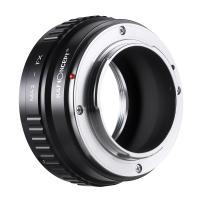What Is The Advantage Of Electron Microscope ?
The advantage of an electron microscope is its high resolution and magnification capabilities. It uses a beam of electrons instead of light to create an image, allowing for much greater detail to be observed. This enables scientists to study the fine structure of materials and biological specimens at a level not possible with traditional light microscopes. Electron microscopes are particularly useful in fields such as materials science, nanotechnology, and biology, where the ability to visualize and analyze tiny structures is crucial. Additionally, electron microscopes can provide information about the chemical composition of a sample through techniques such as energy-dispersive X-ray spectroscopy (EDS) or electron energy loss spectroscopy (EELS). Overall, the advantage of electron microscopes lies in their ability to reveal intricate details and provide valuable insights into the microscopic world.
1、 Higher resolution for detailed imaging of small structures.
The advantage of an electron microscope is its ability to provide higher resolution for detailed imaging of small structures. Unlike light microscopes, which use visible light to illuminate specimens, electron microscopes use a beam of electrons to create an image. This allows for much greater magnification and resolution, making it possible to observe and study structures at the nanoscale level.
One of the key advantages of electron microscopes is their ability to reveal fine details that are not visible with other types of microscopes. The wavelength of electrons is much shorter than that of visible light, allowing for higher resolution imaging. This means that electron microscopes can capture images with much greater clarity and detail, making it possible to study the intricate structures of cells, tissues, and even individual molecules.
In recent years, electron microscopy has become even more powerful with the development of advanced techniques such as cryo-electron microscopy (cryo-EM). Cryo-EM allows researchers to study biological samples in their native, hydrated state, providing a more accurate representation of their structure and function. This technique has revolutionized the field of structural biology, enabling scientists to visualize complex macromolecular structures in unprecedented detail.
Furthermore, electron microscopes can also be used to analyze the chemical composition of a sample through techniques such as energy-dispersive X-ray spectroscopy (EDS). EDS allows researchers to identify and map the distribution of elements within a sample, providing valuable insights into its composition and properties.
Overall, the advantage of electron microscopes lies in their ability to provide higher resolution imaging, allowing for the detailed study of small structures. With advancements in technology and techniques, electron microscopy continues to play a crucial role in various scientific disciplines, from materials science to biology and beyond.

2、 Ability to visualize objects at nanoscale.
The advantage of an electron microscope lies in its ability to visualize objects at the nanoscale. Unlike traditional light microscopes, which are limited by the wavelength of visible light, electron microscopes use a beam of electrons to illuminate the sample, allowing for much higher resolution imaging.
The nanoscale is a realm that is not visible to the naked eye or even to most conventional microscopes. However, with an electron microscope, scientists can observe and study objects at the atomic and molecular level. This level of detail is crucial in various fields of research, including materials science, biology, and nanotechnology.
In materials science, electron microscopes enable researchers to examine the structure and composition of materials with unprecedented precision. This information is vital for understanding the properties and behavior of materials, which can lead to the development of new and improved materials for various applications. For example, electron microscopy has been instrumental in the development of advanced materials for electronics, energy storage, and biomedical devices.
In biology, electron microscopes have revolutionized our understanding of cellular structures and processes. They have allowed scientists to visualize the intricate details of cells, organelles, and even individual molecules. This knowledge has led to breakthroughs in areas such as cell biology, neurobiology, and immunology. For instance, electron microscopy has provided insights into the structure and function of proteins, which are crucial for drug discovery and development.
Moreover, electron microscopy has become increasingly powerful and versatile in recent years. Advances in technology have led to the development of high-resolution electron microscopes capable of capturing images with atomic-scale resolution. Additionally, techniques such as cryo-electron microscopy have enabled the visualization of biological samples in their native state, providing valuable information about their structure and function.
In conclusion, the advantage of electron microscopy lies in its ability to visualize objects at the nanoscale. This capability has revolutionized various fields of research, allowing scientists to explore and understand the intricate details of materials and biological systems. With ongoing advancements in electron microscopy technology, we can expect even greater insights into the nanoworld and its applications in the future.

3、 Enhanced depth of field for 3D imaging.
The advantage of an electron microscope is its ability to provide enhanced depth of field for 3D imaging. Unlike traditional light microscopes, which use visible light to illuminate specimens, electron microscopes use a beam of electrons. This allows for much higher resolution and magnification, enabling scientists to observe and analyze structures at the nanoscale level.
One of the key benefits of electron microscopy is its ability to capture images with a greater depth of field. This means that more of the specimen can be in focus at once, allowing for a clearer and more detailed 3D representation. This enhanced depth of field is particularly useful when studying complex structures or samples with varying depths, as it enables researchers to visualize and understand the spatial relationships between different components.
In recent years, advancements in electron microscopy technology have further improved the depth of field capabilities. For example, the development of scanning electron microscopes (SEM) with advanced detectors and algorithms has allowed for the capture of high-resolution images with extended depth of field. Additionally, techniques such as focus stacking and image processing have been employed to further enhance the depth of field and improve the overall quality of 3D imaging.
The enhanced depth of field provided by electron microscopes has revolutionized various scientific fields. In biology, researchers can now study intricate cellular structures and organelles in unprecedented detail, leading to breakthroughs in understanding cellular processes and diseases. In materials science, electron microscopy has enabled the examination of nanomaterials and their properties, contributing to advancements in fields such as nanotechnology and materials engineering.
In conclusion, the advantage of electron microscopes lies in their ability to provide enhanced depth of field for 3D imaging. This capability allows for clearer and more detailed visualization of complex structures, leading to significant advancements in various scientific disciplines. With ongoing advancements in electron microscopy technology, the potential for further improving depth of field and 3D imaging is promising, opening up new avenues for scientific exploration and discovery.

4、 Capable of imaging non-conductive samples.
The advantage of an electron microscope is its capability to image non-conductive samples. Unlike traditional light microscopes, which use visible light to illuminate samples, electron microscopes use a beam of electrons to create high-resolution images. This allows for the visualization of samples that are not conductive, such as ceramics, polymers, and biological specimens.
One of the main reasons electron microscopes are capable of imaging non-conductive samples is because they do not rely on the conductivity of the sample to generate an image. Instead, the electron beam interacts with the sample, producing signals that can be detected and used to create an image. This makes electron microscopy a valuable tool in various fields, including materials science, nanotechnology, and biology.
In recent years, there have been advancements in electron microscopy techniques that further enhance the imaging of non-conductive samples. For example, the introduction of environmental scanning electron microscopy (ESEM) allows for the imaging of samples in their natural, hydrated state. This is particularly useful in biological research, as it enables the observation of living cells and tissues without the need for extensive sample preparation.
Furthermore, the development of scanning transmission electron microscopy (STEM) has revolutionized the field by providing atomic-scale resolution. STEM allows researchers to not only visualize the surface of non-conductive samples but also probe their internal structure and composition. This has opened up new possibilities for studying materials at the nanoscale and understanding their properties and behavior.
In conclusion, the advantage of electron microscopy lies in its ability to image non-conductive samples. This capability has been further enhanced with advancements in techniques such as ESEM and STEM, allowing for the visualization of samples in their natural state and providing atomic-scale resolution. Electron microscopy continues to be a powerful tool in various scientific disciplines, enabling researchers to explore and understand the microscopic world in unprecedented detail.







































